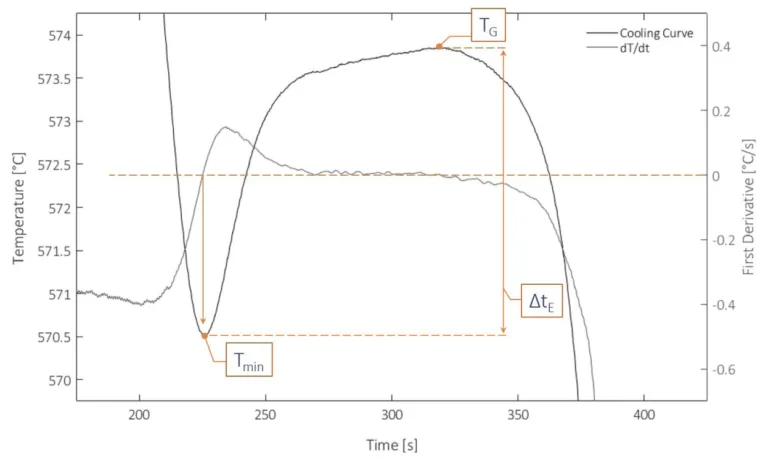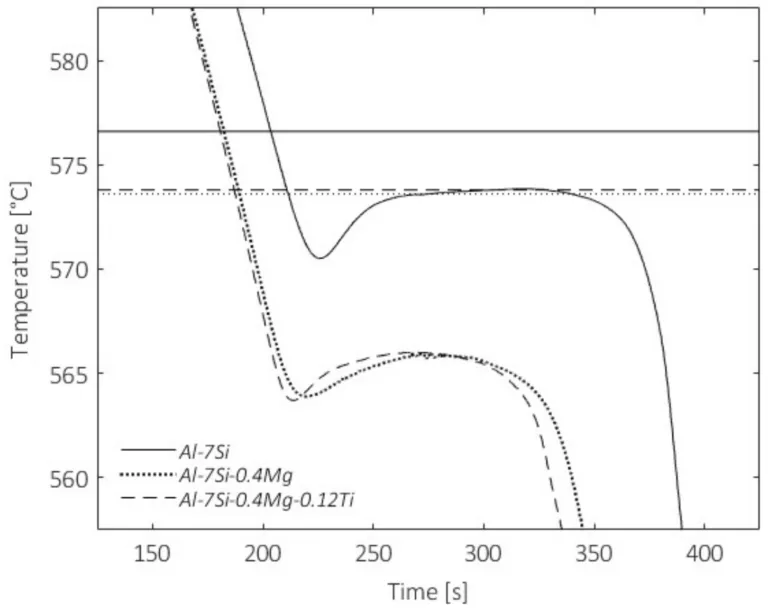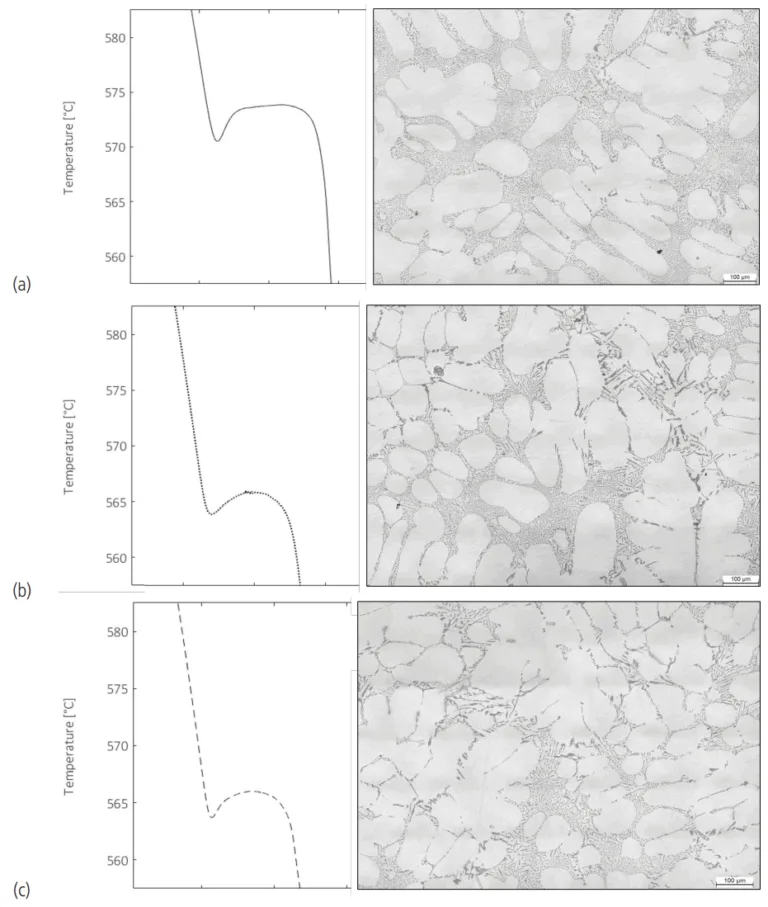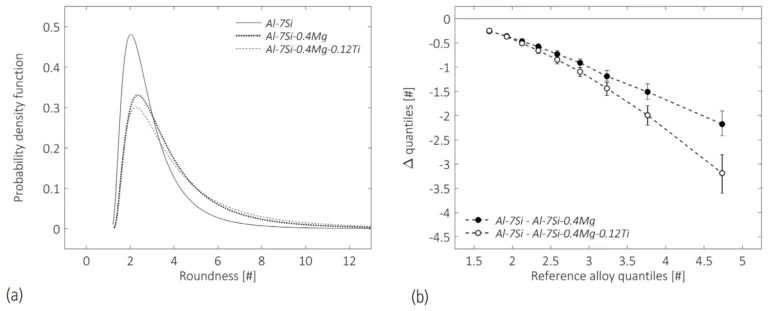This introduction paper is based on the paper "Influence of Mg and Ti on both eutectic solidification and modifying efficiency in Sr-modified Al-7Si cast alloys" published by "La Metallurgia Italiana".
![Tab. 1 – Chemical composition [wt. %] of the reference alloys](https://castman.co.kr/wp-content/uploads/image-2215-1024x199.webp)
1. Overview:
- Title: Influence of Mg and Ti on both eutectic solidification and modifying efficiency in Sr-modified Al-7Si cast alloys
- Author: L. Lattanzi, A. Fortini, M. Giovagnoli, M. Merlin
- Year of publication: 2018
- Journal/academic society of publication: La Metallurgia Italiana
- Keywords: AL-SI ALLOYS, SR MODIFICATION, THERMAL ANALYSIS, SI PARTICLES, ELEMENTS INTERACTION
2. Abstract:
Magnesium and titanium are the main alloying elements always present in a commercial A356 alloy, and strontium is commonly added to achieve a good degree of modification of the eutectic structure. Whilst most of the studies have been focused on the role of strontium on commercial A356 alloy, little attention has been paid to understand the possible interaction of magnesium and titanium with the modifying efficiency of strontium.
In the light of these aspects, the present study is aimed at investigating the effects of magnesium and titanium on the microstructural evolution of Sr-modified Al-7Si, Al-7Si-0.4Mg and Al-7Si-0.4Mg-0.12Ti alloys. To assess the role of Sr on the eutectic solidification path, the analysis of the cooling curves combined with a quantitative microstructural evaluation of the eutectic silicon particles has been carried out. Thermal analysis results highlight how the alloys that contain magnesium show a significant decrease, higher than 5 °C, of the thermal parameters of the eutectic solidification, with respect to the Al-7Si alloy. On the other hand, titanium seems to have only a slight effect on the same solidification characteristics. Metallographic investigations and the related statistical analysis of some geometrical parameters of the silicon particles indicate that the presence of magnesium and titanium induces a variation of both dimension and morphology of the particles. As a result, these experimental findings suggest that the effect of alloying elements, such as titanium and magnesium, on the thermal parameters obtained from cooling curves has to be taken into consideration when the thermal analysis is used to assess the strontium modification efficiency.
3. Introduction:
Al-Si alloys are predominant aluminium alloys used for a wide variety of automotive and aircraft cast components due to their low weight, good castability, low cost, and favourable mechanical properties, which depend on the microstructure from the solidification process. Considerable research has focused on improving their characteristics through melt inoculation [1,2], alloying [3], and tuning heat treatment parameters [4].
Thermal Analysis (TA) is an effective non-destructive and rapid on-line monitoring technique for the metal casting industry, used to evaluate melt quality and monitor processing parameters. TA provides information on grain refinement, modification degree [5,6], characteristic temperatures of primary and eutectic phase solidification [7,8], and intermetallic phase formation [9]. The depression of eutectic growth temperature has been used to assess melt modification level, suggesting a correlation between thermal and microstructural parameters of the eutectic phase [10]. However, there is a scarcity of studies on the interaction between modifiers and alloying elements and its effect on TA cooling curves [11,12].
4. Summary of the study:
Background of the research topic:
Magnesium and titanium are common alloying elements in commercial A356 (Al-7Si based) alloys, where strontium is often added for eutectic modification. While Sr's role is well-studied, the interaction of Mg and Ti with Sr's modifying efficiency is less understood. The influence of alloying elements on microstructural and mechanical features of Al-Si alloys is well-established, and Thermal Analysis (TA) is gaining acceptance for melt quality control. However, the effects of chemical composition on cooling curve parameters, particularly the assessment of Sr modification efficiency via TA considering alloying element interactions, have received little attention [11,34].
Status of previous research:
The control of microstructure, especially silicon particle size and morphology, is crucial for Al-Si alloy properties. Chemical modification, often with strontium, transforms coarse plate-like silicon into a fine fibrous structure [8,13,14]. Magnesium is added to promote Mg₂Si precipitation and improve mechanical properties; some studies suggest Mg slightly increases silicon modification level [21] or shows a weak modifying effect itself [11,22]. Titanium is added for grain refinement [23], though its effect on SDAS might be minimal [7], and it can influence TA parameters [7,24]. Quantitative image analysis coupled with statistical approaches has been used to study the effects of alloying elements and heat treatments on silicon particle distribution [25,26]. The analysis of cooling curves (TA) is widely used to evaluate modification degree, particularly by observing the difference in eutectic growth temperature [9,10] and other parameters like recalescence and eutectic plateau duration [8,32,33]. However, the interaction of alloying elements on the solidification path has not been extensively examined so far [11]. Heusler and Schneider [11] investigated Mg's influence on Na and Sr modification efficiency. Tahiri et al. [12] explored the combined addition of grain refiners and Sr, noting a partial decrease in Sr's modifying efficiency due to reaction with TiB₂.
Purpose of the study:
The present study aims to experimentally investigate the influence of magnesium and titanium on the microstructural evolution of strontium modified Al-7Si, Al-7Si-0.4Mg and Al-7Si-0.4Mg-0.12Ti alloys. Specifically, it examines the changes in the eutectic phase solidification of strontium modified alloys arising from magnesium and titanium additions. The study also attempts to provide a quantitative evidence of the eutectic phase changes through a combined approach of cooling curves analysis and quantitative metallographic investigation on eutectic silicon particles.
Core study:
The core of the study involves preparing three Sr-modified Al-Si alloys: Al-7Si, Al-7Si-0.4Mg, and Al-7Si-0.4Mg-0.12Ti. The study focuses on analyzing their cooling curves during solidification, particularly the eutectic solidification region, to determine thermal parameters. This is combined with a quantitative microstructural evaluation of eutectic silicon particles, including their equivalent diameter and roundness, using image analysis and statistical methods. The mutual effect of Mg and Ti additions on Sr modification efficiency is assessed by comparing these thermal and microstructural parameters across the different alloys.
5. Research Methodology
Research Design:
Three different reference alloys were prepared: Al-7Si, Al-7Si-0.4Mg, and Al-7Si-0.4Mg-0.12Ti. Primary aluminium ingots, pure silicon, pure magnesium, and AlTi10 master alloy were used as appropriate. Melts were degassed with nitrogen. AlSr15 master alloy was added to achieve a targeted strontium content of 100 ppm. The actual chemical compositions were verified by Optical Emission Spectrometer (OES) analysis (Tab. 1).
Thermal analysis was conducted by pouring melts into a pre-heated steel cup, with cooling curves recorded using a K-type thermocouple. Quantitative Image Analysis (IA) was performed on sectioned samples from the TA tests.
Data Collection and Analysis Methods:
Thermal Analysis (TA): Cooling curves were recorded using a K-type thermocouple (1.5 mm diameter) located in the centre of the cup, 15 mm from the bottom. Temperature and time data were recorded at 20 Hz. Cooling curves and their first derivatives were processed using a tailored Matlab® code for smoothing, curve fitting, and determination of characteristic solidification temperatures (Tmin, TG). Recalescence undercooling (ΔTE = TG - Tmin) and depression in eutectic growth temperature (ΔTG) were calculated. TG,0 (growth temperature of unmodified alloy) was estimated using Eq. 1 [35].
Image Analysis and Statistical Evaluation: Samples from TA were sectioned transversely, and prepared using standard metallographic procedures. Quantitative Image Analysis (IA) was performed using a Leica DMi8 A optical microscope with Leica Application Suite 4.9 image analysis software. An investigated area of 4 mm² was chosen close to the centre of the sample surface. 5 composite images (each of 25 micrographs at 500×) were analyzed per specimen, ensuring analysis of 6000-10000 particles. Equivalent Diameter (ED) and Roundness (R) of eutectic silicon particles were statistically analysed using a customised Matlab® code. 3-parameters lognormal distribution was found to be the best fit. Comparisons between distributions were made using decile differences calculated with the Harrell-Davis (HD) quantile estimator [37], with confidence intervals derived via bootstrap estimation. The False Discovery Rate (FDR) was controlled using the Benjamini-Hochberg procedure [38].
Research Topics and Scope:
The research focused on:
- The influence of Mg (0.4 wt.%) and Ti (0.12 wt.%) additions on the eutectic solidification thermal parameters (Tmin, TG, ΔTE, ΔTG) of Sr-modified (approx. 100 ppm Sr) Al-7Si alloys.
- The effect of these alloying elements on the microstructure of Sr-modified Al-7Si alloys, specifically the dimension (Equivalent Diameter) and morphology (Roundness) of eutectic silicon particles.
- The correlation between thermal analysis parameters and microstructural features to assess the modifying efficiency of strontium in the presence of Mg and Ti.
- The alloys investigated were Al-7Si, Al-7Si-0.4Mg, and Al-7Si-0.4Mg-0.12Ti, all modified with strontium.
6. Key Results:
Key Results:
Thermal Analysis (TA):
- In the Al-7Si alloy, strontium addition (100 ppm) determined a decrease of the eutectic TG of about 2.8 °C (Tab. 3, Fig. 2).
- The addition of magnesium (Al-7Si-0.4Mg alloy) led to a significant decrease of both minimum (Tmin) and growth (TG) temperatures during Al-Si eutectic solidification, by about 8 °C, compared to the Sr-modified Al-7Si alloy (Fig. 2). The ΔTG increased to about 7.8 °C (Tab. 3).
- The presence of titanium (Al-7Si-0.4Mg-0.12Ti alloy) seemed to have a slightly similar effect to Mg, causing a further slight decrease of Tmin, with ΔTG at about 7.7 °C (Tab. 3).
- Magnesium and titanium additions did not appear to produce an adverse effect on strontium modification performance based on cooling curve temperatures, as they did not cause a rise in eutectic solidification temperatures.
- Recalescence undercooling (ΔTE) was about 3.2-3.3 °C for the Al-7Si alloy, and decreased to 2-2.3 °C in the presence of magnesium and both magnesium and titanium (Tab. 3).
Microstructural Analysis:
- Strontium addition to Al-7Si alloy (Fig. 3a) resulted in a fully modified eutectic morphology with fine silicon particles.
- The simultaneous presence of magnesium and strontium (Al-7Si-0.4Mg, Fig. 3b) led to a partially modified eutectic structure, with regions of coarse silicon particles alongside finely modified regions.
- Titanium presence in the Al-7Si-0.4Mg-0.12Ti alloy (Fig. 3c) did not determine a significant variation of the microstructure already observed in the alloy with sole magnesium.
- Equivalent Diameter (ED) of Si particles (Fig. 4):
- All alloys showed ED distributions in a range of very small values, with peaks between 2-3 µm, indicating good modification.
- The presence of Mg led to a decrease in the maximum probability density and an increase in the right tail of the ED distribution. Ti enhanced this effect.
- Quantile comparison (Fig. 4b) showed that alloys with Mg and Mg+Ti had statistically significant shifts towards slightly higher ED values for most deciles compared to the binary Al-7Si alloy, especially for the last deciles, indicating a higher probability of finding larger particles.
- Roundness (R) of Si particles (Fig. 5):
- The binary Al-7Si alloy showed the highest peak probability density and minimum spread for Roundness.
- Mg and Mg+Ti additions caused the Roundness distribution to become flatter with a taller right tail (Fig. 5a).
- Quantile comparison (Fig. 5b) indicated that Mg addition increased the number of silicon particles with high roundness values (less fibrous, more lamellar/acicular), reducing Sr modification efficiency. A slight further deterioration was observed with Ti. This is attributed to a "poisoning effect" of Mg on Sr modification, possibly due to the formation of Mg₂Sr(Si,Al)ₓ compounds.
Overall:
- The ΔTG parameter should be used cautiously for assessing modification level when comparing different alloys, as each alloying element can influence its numerical value.
- Magnesium and titanium additions affect the efficiency of strontium modification, leading to a less homogenous and coarser eutectic silicon structure despite the observed depression in eutectic temperatures.
Figure Name List:
- Fig. 1 - Eutectic solidification region of a cooling curve and its first derivative and related thermal parameters
- Fig. 2 - Cooling curves, restricted to the eutectic solidification region, of the investigated alloys modified with 100 ppm of strontium. The horizontal lines represent the TG,0 values related to each alloy
- Fig. 3 - Comparison of microstructures of the three different alloys with 100 ppm of strontium: a) Al-7Si; b) Al-7Si-0.4Mg; c) Al-7Si-0.4Mg-0.12Ti
- Fig. 4 – a) Distributions of equivalent diameter for the alloys with 100 ppm of Sr; b) Comparison of distributions, Al-7Si taken as reference alloy
- Fig. 5 – a) Distributions of roundness for the alloys with 100 ppm of Sr; b) Comparison of distributions, Al-7Si taken as reference alloy
7. Conclusion:
The study investigated the interaction between magnesium, titanium, and strontium in Al-7Si alloys. Key conclusions are:
- Cooling curves for Al-7Si, Al-7Si-0.4Mg, and Al-7Si-0.4Mg-0.12Ti (all modified with 100 ppm Sr) showed that magnesium significantly decreases both Tmin and TG of eutectic solidification. Titanium addition had a slight further similar effect.
- Microstructural observations indicated that while Sr fully modified the Al-7Si alloy (fine, fibrous Si), the presence of magnesium led to a partially modified eutectic structure. Titanium did not significantly alter this microstructure further.
- Statistical analysis of Equivalent Diameter and Roundness (fitted with 3-parameters log-normal distribution) showed that Mg presence decreased the maximum probability density and increased the right tail of the distributions. Quantile comparison revealed that Mg (and further Ti) led to a higher probability of larger and less rounded (more coarse/lamellar) Si particles compared to the binary Al-7Si alloy.
- These results suggest that the ΔTG parameter should be used cautiously when comparing different alloys for modification assessment, as alloying elements influence its value. Despite depressing eutectic temperatures, Mg (and Ti to a lesser extent) can reduce Sr modification efficiency, leading to variations in eutectic Si particle dimensions and morphology.
- It is important to improve thermal analysis reliability, possibly by developing a reference database of thermal parameters for various alloying elements, to better correlate thermal parameters with modification efficiency.
8. References:
- [1] Greer A.L., Cooper P.S., Meredith M.W., Schneider W., Schumacher P., Spittle J.A., Tronche A., Grain Refinement of Aluminium Alloys by Inoculation. 2003, Advanced Engineering Materials, 5, 1-2, 81-91.
- [2] Quested T.E., Understanding mechanisms of grain refinement of aluminium alloys by inoculation. 2004, Materials Science and Technology, 20, 11, 1357-1369.
- [3] Darlapudi A., McDonald S.D., StJohn D.H., The influence of Cu, Mg and Ni on the solidification and microstructure of Al-Si alloys. 2016, IOP Conference Series: Materials Science and Engineering, 117, 1, 1-7.
- [4] Tocci M., Pola A., Raza L., Armellin L., Afeltra U., Optimization of heat treatment parameters for a non-conventional Al-Si-Mg alloy with Cr addition by DoE method. 2016, La Metallurgia Italiana, 6, 141-144.
- [5] Farahany S., Ourdjini A., Idris M.H., The usage of computer-aided cooling curve thermal analysis to optimise eutectic refiner and modifier in Al-Si alloys. 2012, Journal of Thermal Analysis and Calorimetry, 109, 1, 105-111.
- [6] Farahany S., Idris M.H., Ourdjini A., Faris F., Ghandvar H., Evaluation of the effect of grain refiners on the solidification characteristics of an Sr-modified ADC12 die-casting alloy by cooling curve thermal analysis. 2015, Journal of Thermal Analysis and Calorimetry, 119, 3, 1593-1601.
- [7] Xu C., Wang C., Yang H., Liu Z., Yamagata H., Ma C., Solidification Behavior and Mechanical Properties of Al-Si-Mg Alloy with Ti Addition. 2016, Materials science forum, 850, 594-602.
- [8] Zamani M., Seifeddine S., Determination of optimum Sr level for eutectic Si modification in Al-Si cast alloys using thermal analysis and tensile properties. International Journal of Metalcasting, 2016, 10, 4, 457-465.
- [9] Shabestari S., Ghodrat S., Assessment of modification and formation of intermetallic compounds in aluminum alloy using thermal analysis. 2007, Materials Science and Engineering A, 467, 1, 150-158.
- [10] Djurdjevic M., Jiang H., Sokolowski J., On-line prediction of aluminum-silicon eutectic modification level using thermal analysis. 2001, Materials Characterization, 46, 31-38.
- [11] Heusler L., Schneider W., Influence of alloying elements on the thermal analysis results of Al-Si cast alloys. 2002, Journal of Light Metals, 2, 17-26.
- [12] Tahiri H., Mohamed S.S., Samuel F.H., Doty H.W., Valtierra S., Effect of Sr-Grain Refining-Si Interactions on the Microstructural Characteristics of Al-Si Hypoeutectic Alloys. 2017, International Journal of Metalcasting, 1-19.
- [13] Manente A., Timelli G., Influence of strontium modification and solidification history on the microstructure of as cast Al-Si alloys. 2008, La Metallurgia Italiana, 10(10), 1-14.
- [14] Timelli G., Caliari D., Rakhmonov J., Influence of process parameters and Sr addition on the microstructure and casting defects of LPDC A356 alloy for engine blocks. 2016, Journal of Materials Science and Technology, 32, 515-523.
- [15] Shabestari S.G., Shahri F., Influence of modification, solidification conditions and heat treatment on the microstructure and mechanical properties of A356 aluminum alloy. 2004, Journal of Materials Science, 39, 2023-2032.
- [16] Rakhmonov J., Timelli G., Bonollo F., Influence of melt superheat, Sr modifier and Al-5Ti-1B grain refiner on microstructural evolution of secondary Al-Si-Cu alloys. 2016, Metallurgical and Materials Transactions A: Physical Metallurgy and Materials Science, 47, 5510-5521.
- [17] Caceres C.H., Davidson C.J., Griffiths J.R., Wang Q.G., The effect of Mg on the microstructure and mechanical behavior of Al-Si-Mg casting alloys. 1999. Metallurgical and Materials Transactions A, 30, 10, 2611-2618.
- [18] Yildirim M., Özyürek D., The effects of Mg amount on the microstructure and mechanical properties of Al-Si-Mg alloys. 2013, Materials and Design, 51, 767-774.
- [19] Sanna F., Fabrizi A., Ferraro S., Timelli G., Ferro P., Bonollo F., Multiscale characterization of AlSi9Cu3(Fe) die casting alloys after Cu, Mg, Zn and Sr addition. 2013, La Metallurgia Italiana, 105(4), 13-24.
- [20] Li Q., Li B., Li J., Xia T., Lan Y., Guo T., Effects of the addition of Mg on the microstructure and mechanical properties of hypoeutectic Al-7%Si alloy. 2017, International Journal of Metalcasting, 11, 4, 823-830.
- [21] Aguilera-Luna I., Castro-Román M.J., Escobedo-Bocardo J.C., García-Pastor F.A., Herrera-Trejo M., Effect of cooling rate and Mg content on the Al-Si eutectic for Al-Si-Cu-Mg alloys. 2014, Materials Characterization, 95, 211-218.
- [22] Joenoes A.T., Gruzleski J.E., Magnesium effects on the microstructure of unmodified and modified Al-Si alloys. 1991, Cast Metals, 4, 2, 62-71.
- [23] Rakhmonov J., Timelli G., Bonollo F., The influence of AlTi5B1 grain refinement and cooling rate on the formation behavior f Fe-rich compounds in secondary AlSi8Cu3 alloys. 2016, La Metallurgia Italiana, 108(6), 109-112.
- [24] Golbahar B., Samuel E., Samuel A.M., Doty H.W., Samuel F.H., On thermal analysis, macrostructure and microstructure of grain refined Al-Si-Mg cast alloys: role of Sr addition. 2014, International Journal of Cast Metals Research, 27, 5, 257-266.
- [25] Alexopoulos N.D., Tiryakioğlu M., Vasilakos A.N., Kourkoulis S.K., The effect of Cu, Ag, Sm and Sr additions on the statistical distributions of Si particles and tensile properties in A357-T6 alloy castings. 2014, Materials Science and Engineering A, 604,40-45.
- [26] Tiryakioğlu M., Si particle size and aspect ratio distributions in an Al–7%Si-0.6%Mg alloy during solution treatment. 2008, Materials Science and Engineering A, 473, 1-6.
- [27] Samuel A.M., Doty H.W., Valtierra S., Samuel F.H., Effect of grain refining and Sr-modification interactions on the impact toughness of Al-Si-Mg cast alloys. 2014, Materials and Design, 56, 264-273.
- [28] Ibrahim M.F., Elgallad E.M., Valtierra S., Doty H.W., Samuel F.H., Metallurgical parameters controlling the eutectic silicon characteristics in Be-treated Al-Si-Mg alloys. 2016, Materials, 9, 78.
- [29] Abdelrahman M.S., Abdu M.T., Khalifa W., Assessment of eutectic modification level in Al-Si alloys via thermal analysis. 2017, Light Metals, 885-895.
- [30] Wilcox R.R., Comparing two independent groups via multiple quantiles. 1995, The Statistician, 44, 1, 91-99.
- [31] Wilcox R.R., Erceg-Hurn D., Clark F., Carlson M., Comparing two independent groups via the lower and the upper quantiles. 2014, Journal of Statistical Computation and Simulation, 84, 7, 1543-1551.
- [32] Niklas A., Abaunza U., Fernández-Calvo A.I., Lacaze J., Suárez R., Thermal analysis as a microstructure prediction tool for A356 aluminium parts solidified under various cooling conditions. 2011, In: 69th World Foundry Congress (WFC), 16-20 Oct 2010, Hangzhou, China.
- [33] Malekan M., Dayani D., Mir A., Thermal analysis study on the simultaneous grain refinement and modification of 380.3 aluminum alloy. 2014, Journal of Thermal Analysis and Calorimetry, 115, 1, 393-399.
- [34] Moustafa M.A., Lepage C., Samuel F.H., Doty H.W., Metallographic observations on phase precipitation in strontium-modified Al-11.7% Si alloys: Role of alloying elements. 2003, International Journal of Cast Metals Research, 15, 6, 609-626.
- [35] Apelian D., Sigworth G.K., Whaler K.R., Assessment of grain refinement and modification of Al-Si foundry alloys by thermal analysis. 1984, AFS Transactions, 297-307.
- [36] McDonald S.D., Nogita K., Dahle A.K., Eutectic nucleation in Al-Si alloys. 2004, Acta Materialia, 52, 14, 4273-4280.
- [37] Harrell F.E., A new distribution-free quantile estimator. 1982, Biometrika, 69, 3, 635-640.
- [38] Benjamini Y., Hochberg Y., Controlling the false discovery rate: a practical and powerful approach to multiple testing. 1995, Journal of the Royal Statistical Society B, 57, 1, 289-300.
- [39] Chen X., Geng H., LI Y., Assessment of modification level of hypoeutectic Al -Si alloys by pattern recognition of cooling curves. 2005, China Foundry, 2, 4, 246-253.
- [40] Nogita K., McDonald S.D., Dahle A.K., Eutectic solidification and its role in casting porosity formation. 2004, Journal of Minerals, Metals and Materials Society, 52-58.
- [41] Laslz G., Dual microstructure in hypoeutectic Al-Si alloys: dendrites and eutectic grains. Its effects on shrinkage behaviour. 1995, Proceedings of the 4th International Conference on Molten Aluminum Processing, 459-480.
- [42] McDonald S.D., Nogita K., Dahle A.K., Eutectic grain size and strontium concentration in hypoeutectic aluminium-silicon alloys. 2006, Journal of Alloys and Compounds, 422, 184-191.
9. Copyright:
- This material is a paper by "L. Lattanzi, A. Fortini, M. Giovagnoli, M. Merlin". Based on "Influence of Mg and Ti on both eutectic solidification and modifying efficiency in Sr-modified Al-7Si cast alloys".
- Source of the paper: [DOI URL not explicitly provided in the OCR text of the paper]
This material is summarized based on the above paper, and unauthorized use for commercial purposes is prohibited.
Copyright © 2025 CASTMAN. All rights reserved.



